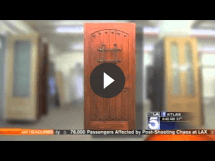
Oh Christmas tree, oh Christmas tree, how lovely are your fake, no real, no fake branches. Yes, it’s that time of year again: the time to go out on a limb and decide what kind of Christmas tree is worthy of being displayed from the corner of our living rooms. Now, some of us may be set in our ways, believing that we should only buy real trees and that fake ones are the forest industry’s version of breast implants. Others may disagree, believing that fake ones are just as good as anything Mother Nature can grow.
Whether your heart belongs to real Christmas trees or you raise the roof for fake ones, both kinds have their advantages and their disadvantages.
Convenience: Whenever we think of real Christmas trees, it’s hard not to think of that scene from National Lampoon’s Christmas Vacation where the family goes out to cut down their own tree, virtually freezing in the process. While getting a real tree isn’t as inconvenient as Chevy Chase would have you believe, it’s still less convenient than a fake one. Fake trees last years: instead of going to a tree farm every December you only need to go up to the attic and drag down old faithful. There’s also less of a mess with fake trees: they don’t shed their pine leaves the way the real ones do. This, naturally, makes them a favorite among vacuum cleaners.
Cost: Fake trees can be expensive, especially when they come with preinstalled lights and ornaments (bringing a new sense of laziness to the holidays). However, because of their durability, many fake trees pay for themselves over time: it’s just the initial cost that’s overwhelming. On the flip side, real trees are usually less expensive, but they are an “one time only†kind of product. The number of real trees you buy each year may eventually overtake the cost of one fake tree. Thus, the price can be a bit of a crapshoot: your decision might just depend on the other characteristics for which you are “pining.â€
Tradition: When it comes to Christmas tradition, it’s hard not to fall in favor of a real tree. Plainly put, going to a tree farm and picking out a real pine is much more traditional than going to Walmart and picking out a real piece of plastic. For some people, this kind of custom may be important, for others, it might not be. Some people may love the tradition of finding the perfect Christmas tree, while others may focus their energies on the tradition of finding their hidden presents before December 25th.
Ambiance: Just as we fall in favor of real Christmas trees from a traditional standpoint, they also get the nod when it comes to ambiance. Real trees smell like Christmas, they look like Christmas, and they bring in a sense of ambiance that no fake tree ever will. Fake trees are, well, fake: they look fake, the smell fake, they act fake, and they talk with a fake British accent.
Environment: It may seem like buying a fake tree is the eco-friendly thing to do, but that’s not necessarily the case. Many fake trees contain lead, additives, and plastic that – when being made – dangerously seeps out into the environment. They are also sometimes made in labor-intensive, unfair work settings. Real Christmas trees, however, aren’t necessarily BFF’s to Mother Nature either. They are farmed using pesticides and, upon being discarded, can cause watershed pollution. However, unlike the fake trees, the real ones have a branch of hope.
According to the National Christmas Tree Association, the most environmentally friendly thing to do is buy a real Christmas tree that still has its roots and replants it in your front or back yard after the holiday season. This, unfortunately, can get tricky: if a tree is to be replanted, it can only be indoors for about a week. Thus, Christmas tree recycling might be the better option for those people who insist on putting their Christmas tree up on Halloween and taking it down in February.
Posted in Home By


